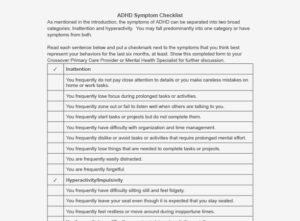
ADHD
Having ADHD, or living with someone who has ADHD, can be very challenging. Based on questions our members are asking, our team has created this self-care package to learn more about ADHD characteristics, along with diagnosing it, tips for managing it, and treatment options—plus, a self-scored ADHD quiz.

What You’ll Learn About ADHD
- Do you or a loved one match ADHD characteristics?
- Get tips for managing focus, organization, burnout, and mindfulness.
- Take our quiz and use our ADHD checklist.
- Get information on medication and non-medication treatment.
- Understand how ADHD affects relationships (self, spouse, parent).
- How your Crossover care team can help
Expert Guidance Along the Way
-
LaTanya Carter, PhDPsychologistA licensed psychologist, LaTanya is from Detroit, and earned two Bachelor's degrees from the University of Michigan in Psychology and African-American and African Studies. She specializes in tailoring treatment for our members to help them move forward towards overall wellbeing and a greater quality of life.
-
Stacey Stocks, LCSWMental Health TherapistStacey is a Licensed Clinical Social Worker with a Bachelor's (Psychology) and Master's (Social Work) degree from the University of Michigan. She wants to create a space where members can get therapy to make a change in their lives and feel supported without judgment. Stacey has worked in the mental health field for over 24 years.
ADHD stands for Attention Deficit Hyperactivity Disorder. There are two different kinds of ADHD: hyperactive and inattentive. ADHD is characterized by a combination of:
- Inattention
- Lack of information retention, even when told something directly
- Difficulty with follow through
- Struggles with organization and time management
- Being easily distracted and forgetful
- Excessive talking
- Difficulty with fidgeting or sitting still
- Interrupting others
- Difficulty relaxing or engaging in leisure activities.
For a more complete list, please reference our symptom checklist on page 7. These symptoms are present for most of one’s life and typically do not have a sudden onset. They can also not be explained by another medical or psychiatric diagnosis.
Important Definitions
Psychologist or Therapist
These are mental health providers who have either a masters or doctorate-level certification and are licensed by a state board. These providers can assist with behavioral techniques, organization, or gaining a better understanding of how your diagnosis affects your life.
Psychiatrist
This is a medical doctor who specializes in mental health. Psychiatrists mainly focus on prescribing medications, but can offer behavioral techniques as well.
What you should know
ADHD affects about 5% of children and 2.5% of adults so if you have it, know that you are not alone. Even if you do not meet the criteria for an ADHD diagnosis, you can still benefit from some of these organizational techniques. More detailed information about what other diagnoses can affect attention are found in the material below.
What Crossover can do for you
 Crossover can help with the diagnosis and management of ADHD. If you try the techniques provided here and continue to struggle, please reach out for more assistance. In addition, if you take the quiz or check many boxes on the checklist, meeting with a provider for more information can help guide you towards an appropriate diagnosis and treatment. Unfortunately, most Crossover providers cannot prescribe medications typically associated with ADHD, but we can arrange for you to see a doctor in your community who has that capability if your Crossover provider is unable to prescribe.
Crossover can help with the diagnosis and management of ADHD. If you try the techniques provided here and continue to struggle, please reach out for more assistance. In addition, if you take the quiz or check many boxes on the checklist, meeting with a provider for more information can help guide you towards an appropriate diagnosis and treatment. Unfortunately, most Crossover providers cannot prescribe medications typically associated with ADHD, but we can arrange for you to see a doctor in your community who has that capability if your Crossover provider is unable to prescribe.
Skills
Acknowledging that your attention is a struggle is part of the journey. But where do you go from here? Below you will find some useful information about ways to change your environment, use technology, and ideally, help you function. If you find you continue to struggle after trying these skills consistently for a few weeks, reach out to your care team.
Tips for Focusing and Working from Home
Finding ways to focus, especially when you are working from home, can be difficult. Below are some things you can try to assist with focus.
- Build in breaks: Our brains are not designed to focus for hours on end. The average person can only attend to tasks for 1.5-3 hours. For individuals with ADHD, that attention span can be even shorter. If possible, schedule breaks during the day to take a quick walk, eat lunch, and look away from a screen. Setting a timer so you don’t forget to take breaks, and to make sure the breaks don’t last too long can help.
- Separate work and home life: Try to designate a separate space for your work so you can try to just be in “work mode” without being distracted by multitasking. Maybe this is a specific desk, or a room in your home if space allows. Set times to start and end work. When you are outside of “working hours,” leave work alone and fully engage in your home life. Giving yourself a break can make it easier to focus when you need to. If it is not possible to designate a space, you can do things like close your computer or shut it down at the end of each work day, or give yourself a cue like turning the light off in the room where you work. Sticking to start and end times for your work day will help you establish work hours and separate work from “free” time.
- Utilize when you work best: Do you get more work done in the morning or afternoon? Use that to your advantage. Plan your work day around when you have the most focus.
Executive Functioning: Organizing your Life and Using Technology
Organization can be a challenge. Not being organized can make focusing, getting work done, or completing tasks difficult for anyone, let alone someone struggling with ADHD. Lacking organization can also feel like a vicious cycle where things slip through the cracks and don’t get done, making you feel worse, which leads to increased avoidance and further disorganization. The below tips can be helpful in building ways to organize your life.
- Start small and develop systems: Tackle one thing at a time. Do you see mail piling up? Maybe a good place to start would be developing a system. Mail goes in one place as soon as you get it and you have a scheduled time once a week to go through and sort/attend to it. Or maybe your email inbox is getting out of hand. Schedule 20 minutes a day to open, respond to, and archive emails. Focusing on small things you can do to solve problems can add up and create more ease.
- Use one to-do list: This can be handwritten or electronic. Using an electronic list has an advantage because you typically have your phone with you and you can link it across devices. Writing things down is a good step, however if you use separate pieces of paper they can get lost, or it can be difficult to determine which piece of paper should take priority. Having one list will help you determine which tasks you’ve already checked off the list, and what tasks still need to be completed. You can also rank them according to importance, so if you only have a few minutes at a time, you know which tasks to focus on first. Writing down your tasks means you don’t have to remember your whole list, which frees up a lot of brain space and mental energy.

- Have a calendar for all appointments: Similar to how a written to-do list on scattered pieces of paper can be lost or confused, if your appointments are not written down they can be easy to forget. Have one calendar (written or electronic) where all of your appointments are scheduled. This makes planning your day easy.
- Use alarms: If you find yourself missing appointments, being late for deadlines, or forgetting to take medication, use your phone to help guide you. Setting alarms throughout the day can help keep you on task by reminding you when to switch routines, take your meds, or leave for that doctor’s appointment. Often these reminders can be integrated into your calendar.
Tips for Procrastination
Procrastination is a common issue for many people, and putting things off can be even more of an issue for people who have trouble focusing. It’s natural to avoid doing things that seem difficult, especially when completing tasks is a struggle. Here are some strategies to help you understand why you procrastinate and how to overcome it.
- Write down good reasons to procrastinate: This may seem counterintuitive, but try asking yourself, “How does postponing a task help me?” Here are some possible good reasons: you feel tired and need to rest before taking it on, the goal is unclear so you need to gather more information prior to starting the task, or there is still plenty of time and you know you perform better when the deadline is closer. You can probably come up with many more. Once you have created a list, see if you can write a counter argument for each, for example, this task will only take a few minutes, I can rest when it’s finished. By doing this activity, you will prepare yourself mentally for thoughts or reasons to procrastinate when they inevitably pop up.
- Put the task on your calendar: Treat the task like an appointment with someone. Without setting a specific time on your calendar, you’ll likely wait until the end of the day, or the end of the week, and the same procrastinating thought (“It’s almost the end of the day, I’ll just do it tomorrow”) can cause you to push it out yet again. Scheduling time to complete the task can help you keep your commitment to yourself to just get it done.
- Break it down to small steps: We tend to procrastinate tasks that seem complex and overwhelming—think about things like filing taxes, writing a long essay, or organizing your files. Breaking a complex task down into more manageable steps, such as creating an outline for your essay, can help. You can even take this one step further, so instead of just gathering your paperwork, you can schedule small tasks on your calendar like 1) create a new document, 2) think of a title, 3) print out the guidelines for the essay, 4) write an outline. The simpler the steps, the more likely they will be achievable. This will also help with the next tip.
- Commit to doing it for just five minutes: Getting started is often the most difficult part of the process. If you commit to taking the first step (like creating a new document), it creates momentum. By giving yourself permission to stop after five minutes, it makes starting feel less overwhelming—committing to doing something for only five minutes usually feels like something you can do. You might notice that after five minutes, you want to continue—that’s a bonus! And if you’re ready to stop, that’s fine, too.
- Hold yourself accountable: Chances are, you don’t like to disappoint someone else by not showing up where you’re expected. For example, people are more likely to exercise if they have an exercise buddy. To hold yourself accountable to your commitments, tasks, or projects, you can set up a time to meet with a friend at a library or a coffee shop to get it done. You can even promise to give $5 to a friend if you don’t start a task on schedule, or keep to your commitment by telling a friend you’ll text them once the task is complete.
Tips for Managing Burnout
Sometimes the symptoms of ADHD can be affected by, or mistaken for something else, like burnout. Anyone can experience burnout, regardless of any mental health conditions. It can occur at work, in school, at home (such as when caring for a dependent), or stress from a combination of these settings. Many people do not realize that they are burnt out because the effect of stress often accumulates slowly and gradually over time. Below are some signs of burnout:
- Overstressed, tightness in back and shoulders, having difficulty sleeping
- Not willing to take time for a vacation because there is so much work to do
- Tendency to catch more colds, and to stay sick longer; experiencing aches, pains, or other physical symptoms associated with stress
- Chronic feeling of being sick, overtired, or having general fatigue
- Feeling of being under supported, or that others don’t care
- Feeling bored at work or home
- Feeling that too many expectations are piling up
- Feeling under-appreciated
- Not looking forward to going to work in the morning
- Lack of caring for family, co-workers, and others
Because burnout is usually a result of an imbalance between work (whether it’s away from home or at home) and time off, self-care is important to cope successfully and try to create more balance. Here are some things to try that might help you connect with yourself and feel more centered:
- Create and maintain contact with a small group of people you can call on for emotional support.
- Take time to play. Spend time with those who make you laugh. Watch a comedy or read a funny book.
- Find activities that soothe and relax you. Relaxation improves the mind and helps the body recover from stress. Even 10 minutes a day helps!

- Do some kind of physical activity, even if you only have a few minutes at a time to devote. Find a routine that gets your heartrate up, makes you sweat, and that you enjoy (e.g., walk, swim, barre class, stationary bike, tennis, etc.).
- Keep a journal. Write down your thoughts and feelings in various situations. Note any patterns or questions you’d like to discuss in counseling.
- Pay attention to your mind and body. Nourish your body with nutritious food and try not to skip meals—being hungry and fatigued robs you of the energy you need to cope. Nurture your spirit—pray, meditate, or do whatever aligns with your spirituality. Sleep and rest when you are tired.
Mindfulness and ADHD
Mindfulness is the basic human ability to be fully present, aware of where we are and what we are doing, while not becoming overly reactive to or overwhelmed by what is going on around us.
Mindfulness is the willingness to experience one’s self (thoughts, feelings, and sensations) and one’s life just as it is. It is the practice of creating space between what your mind says works and matters, and what your experience says works and matters. Mindfulness teaches us how to anchor ourselves in the present without judgment. It gives us the chance to take a look at our initial reactions without becoming attached to them.
It has also been proven to help people living with ADHD in a variety of ways, including:
Improves executive functioning: Practicing Mindfulness strengthens one’s attention, memory, motivation, and learning. It also promotes problem-solving and decision-making.
Enhances emotional wellbeing and self-regulation: Practicing Mindfulness reduces depression, anxiety, negative thinking, and the production of stress hormones. It also fosters relaxation and self-acceptance.
How to Practice Mindfulness
 Find a quiet, calming place and sit in a comfortable position
Find a quiet, calming place and sit in a comfortable position- Set a time limit (Less is more)
- Focus your attention on your breath
- Notice your body as well, observing thoughts, emotions, and sensations.
Notice when your mind has wandered and be kind to it. Accept the wandering and greet it with stillness. Simply return your attention back to your breath. - Close with gratitude after taking one more moment to observe your thoughts, emotions, and physical sensations
ADHD Symptom Checklist
As mentioned in the introduction, the symptoms of ADHD can be separated into two broad categories: Inattention and hyperactivity. You may fall predominantly into one category or have symptoms from both.
Read each sentence in the checklist linked below and put a checkmark next to the symptoms that you think best represent your behaviors for the last six months, at least. Show this completed form to your Crossover Primary Care Provider or Mental Health Specialist for further discussion.
Download ADHD Symptom Checklist
ADHD Symptom Quiz
The following quiz can assess any symptoms you may be experiencing, and help indicate if you have a form of ADHD. While this quiz is not intended to diagnose ADHD, it can be used to help you and your healthcare provider better understand the severity of your symptoms for the purpose of more effective interventions.
ADHD Medication Interventions
ADHD medications come in two forms: stimulants and non-stimulants. These medications work by helping areas of the brain control an individual’s behaviors, increasing attention and memory, and decreasing hyperactivity and impulsive behaviors.
Stimulants are the most researched and most commonly prescribed medications to treat individuals diagnosed with ADHD. Depending on the prescription, effects can last 3-5 hours (short-acting) or 8-12 hours (long-acting).
Stimulant Medications and Side Effects
Below is a list of ADHD stimulant medications:
- Amphetamine (Adzenys XR ODT, Evekeo)
- Amphetamine/Dextroamphetamine (Adderall and Adderall XR)
- Dextroamphetamine (Dexedrine, ProCentra, Zenzedi)
- Dexmethylphenidate (Focalin and Focalin XR)
- Lisdexamfetamine (Vyvanse)
- Methylphenidate (Concerta, Daytrana, Metadate CD and Metadate ER, Methylin and Methylin ER, Ritalin, Ritalin SR, Ritalin LA, Quillivant XR)
The most common side effects may include:
- Headaches
- Upset stomach
- Higher blood pressure
 The most beneficial advantage is that stimulant medications are fast-acting, which means you may see immediate improvement in overall impulsivity and ADHD symptoms. Although stimulant medications are non-habit forming, there is potential for abuse and addiction.
The most beneficial advantage is that stimulant medications are fast-acting, which means you may see immediate improvement in overall impulsivity and ADHD symptoms. Although stimulant medications are non-habit forming, there is potential for abuse and addiction.
The effectiveness of stimulants varies from person to person. Non-stimulants can be used in conjunction with stimulants to boost their effectiveness.
Non-stimulant Medications and Side Effects
Below are a few examples of ADHD non-stimulant medications:
- Atomoxetine (Strattera)
- Clonidine hydrochloride (Kapvay)
- Guanfacine (Intuniv)
The most common side effects may include:
- Upset stomach
- Reduced appetite, which may cause weight loss
- Nausea
- Dizziness
- Fatigue
- Mood swings
Non-stimulants improve overall concentration and impulse control, but must be taken daily and are more slow-acting, meaning it may take a few weeks to notice effectiveness. Non-stimulant medications also decrease ADHD symptoms, especially with impulsivity and aggression, and they have a longer-lasting and smoother effect than many stimulants. They can also be used independently if an individual experiences unwanted side effects, such as significant weight loss. Non-stimulants may also be preferred if an individual has a strong history of addiction as they don’t pose the same risk of abuse or addiction.
Differential Diagnosis And Concurring Symptoms
 Sometimes, psychological or psychiatric conditions can cause symptoms that are similar to ADHD symptoms. The most common of these is depression. People with depression can also have difficulty making decisions, a hard time focusing or concentrating, and low motivation. Anxiety is another common condition. People who experience anxiety often struggle with worrying or negative thoughts about oneself. Anxiety can also make it difficult to multitask. Other conditions that mimic ADHD symptoms include: stress, brain injury, concussion, seizure, or cardiovascular events. Although less common, Bipolar Disorder can also look very similar and share the same features of mood instability, restlessness, impatience, inattention, and impulsivity as those with ADHD. In childhood, ADHD can occur with learning difficulties.
Sometimes, psychological or psychiatric conditions can cause symptoms that are similar to ADHD symptoms. The most common of these is depression. People with depression can also have difficulty making decisions, a hard time focusing or concentrating, and low motivation. Anxiety is another common condition. People who experience anxiety often struggle with worrying or negative thoughts about oneself. Anxiety can also make it difficult to multitask. Other conditions that mimic ADHD symptoms include: stress, brain injury, concussion, seizure, or cardiovascular events. Although less common, Bipolar Disorder can also look very similar and share the same features of mood instability, restlessness, impatience, inattention, and impulsivity as those with ADHD. In childhood, ADHD can occur with learning difficulties.
There is a higher risk of substance abuse with individuals with ADHD. Additionally, effects of alcohol can mimic ADHD symptoms and substance use can cause symptoms that are problematic to cognitive functioning.
Non-Medication Interventions for ADHD
A common question that individuals with ADHD ask is: Do I have to take medication? The answer is: it depends.
For some people, medication is necessary to either reduce symptoms that they would not otherwise be able to control on their own, or to enhance their overall ability to effectively participate in behavioral treatment (see Medication Treatments for ADHD).
However, others may be able to use other methods to successfully manage their ADHD symptoms without the use of medication. Below are some common, research-supported treatments for ADHD that do not rely on medication. The right combination of these treatments may help you better manage your ADHD symptoms and reduce its impairment in your daily life. If you are interested in pursuing any of these treatments, you can make an appointment with our Mental Health Team through the Patient Portal.
Cognitive-Behavioral Therapy
Cognitive-Behavioral Therapy (CBT) is the modification of thoughts and behaviors in order to positively affect change in emotions. In the treatment of ADHD, CBT is used to challenge negative beliefs you may have about yourself that contribute to negative feelings (e.g., “I am lazy.”). It can also be utilized to teach you behavioral strategies to repair areas in your life where ADHD has had a particularly negative impact, such as at work or in relationships. If your ADHD is accompanied with anxiety and/or depression symptoms, CBT is also a helpful intervention for reducing these negative emotions and improving your overall mental wellbeing.
Executive Functioning Skill Building
Executive Functions are a set of mental activities such as problem-solving, decision-making, and impulse control that affect your daily learning, memory, and processing abilities. Research has shown that people with ADHD often have significant weaknesses in their executive functions, causing impairment in their daily lives. However, strengthening these executive functioning abilities is possible. Strategies can be learned to improve self-control, time management, problem-solving skills, procrastination, and more. See Executive Functioning Skill Building for specific strategies on changes you can make that will have a lasting, positive effect on your ADHD symptoms.
Mindfulness
Mindfulness is the mental exercise of being aware of your feelings and sensations in a given moment. Practicing mindfulness can reduce stress and promote mental clarity. Because of tendencies toward distractibility and short attention spans, mindfulness can be challenging for people with ADHD. However, through practicing mindfulness exercises, people with ADHD can retrain their brains to be less responsive to distracting stimuli and increase their attention span. See our Mindfulness videos you can watch to learn how to try building your own mindfulness practice.
Physical Activity
Did you know that being physically active can positively affect your ADHD symptoms? Not only can physical activity reduce the restlessness that people with ADHD sometimes feel but it also can have a positive influence on brain functioning. People with ADHD have lower levels of an important chemical called dopamine in the brain. When you exercise at least 30 minutes per day, the brain produces more dopamine which can improve attention and concentration. Any kind of exercise helps—you can go for a brisk walk, weight train, swim, or take an exercise class. In fact, Crossover offers many free exercise classes for our members (there are classes for every fitness level).
Stress Management
Everyone experiences stress. Stress activates the emotional center of our brain; this emotional center competes with the executive functioning center of our brain and can often override it. It can adversely affect your ability to concentrate and perform well. If you have ADHD, stress can also make symptoms such as distractibility, disorganization, and forgetfulness even worse. Managing your stress through relaxation strategies such as mindfulness, deep breathing, and exercise will lessen the negative effects stress may have on your ability to manage your daily tasks.
Sleep
Our bodies and brains need sleep to reset and restore necessary functions. Without proper sleep, not only do we feel physically tired, it causes our brains to process information less efficiently, leading to difficulty concentrating, poor memory, and shorter attention spans. Research has shown that, for a number of reasons, people with ADHD struggle with falling and staying asleep, which can worsen their ADHD symptoms. Developing (and keeping) a good sleep routine can improve executive functioning abilities and help your whole body—including your brain—feel rested and energized.
Loving and Living with Someone with ADHD
 While it is common for some conflict to occur in relationships, loving and/or living with someone who has ADHD presents its own set of unique challenges. Research shows almost two-thirds of marriages where at least one person in the relationship has ADHD experience some form of conflict. Relationships impacted by ADHD are often challenged by the very symptoms of the disorder: persistent distractibility, inattention, forgetfulness, restlessness, and impulsivity. In addition, the relationship failure rate is twice as high for people living with ADHD. But while ADHD may pose some challenges within families and relationships, there is hope and help to be found. Several relationship experts have identified skills to help strengthen relationships in which ADHD is a consideration. Here are several tips to help you, your partner, and your relationship.
While it is common for some conflict to occur in relationships, loving and/or living with someone who has ADHD presents its own set of unique challenges. Research shows almost two-thirds of marriages where at least one person in the relationship has ADHD experience some form of conflict. Relationships impacted by ADHD are often challenged by the very symptoms of the disorder: persistent distractibility, inattention, forgetfulness, restlessness, and impulsivity. In addition, the relationship failure rate is twice as high for people living with ADHD. But while ADHD may pose some challenges within families and relationships, there is hope and help to be found. Several relationship experts have identified skills to help strengthen relationships in which ADHD is a consideration. Here are several tips to help you, your partner, and your relationship.
ADHD Relationship Skills
Take the time to learn about ADHD
ADHD is not simply a deficit of attention. It is a pervasive, life-long, cognitive and psychological impairment. People living with ADHD suffer from deficiencies in executive functioning including: self-awareness, self-monitoring, inhibition, memory, planning/sense of time, emotional control, impulse control, and self-control. Behaviors that may look intentionally insensitive, selfish, disrespectful, unprepared, and/or overly emotional are actually biological problems originating in your partner’s brain. Understanding this can help you lead with compassion rather than judgment when interacting with your partner.
Acknowledge how ADHD affects you
Many people who live with ADHD can be creative, caring, and fun. But at times, their behaviors can leave partners feeling frustrated or like the diagnosis is the primary focus in the relationship. Parents or partners of a person living with ADHD often neglect their own physical and emotional needs, or place them on hold because their time and attention is centered around their partner so much. This can lead to resentment, unhealthy relationship roles, and tension within the relationship. Taking care of yourself isn’t selfish—it is actually an effective and powerful way to nurture your relationship. If you need it, seek out support, ask for help, and set healthy boundaries within your relationship. It is okay—even helpful—to acknowledge feelings such as anger, frustration, impatience, guilt, and disappointment. These feelings do not make either of you a “bad partner.” Acknowledging your feelings, communicating honestly, and getting a support system in place can be important steps towards taking care of yourself.
Communicate openly and do what works for your relationship
Talking about things like responsibilities, expectations, and schedules can help eliminate confusion and disappointment. Remember that an ADHD diagnosis is just one part of your partner, not the whole person. Set aside some time each week to discuss things like making plans, how your routines are going, and any problems that need solving. This allows couples and families to manage conflict in a more relaxed and focused way, with less arguing or fighting.
Create a Division of Labor
When dividing tasks and chores in the house, try to assign everyone tasks they are best at, even if it isn’t traditional. If your son really loves organizing the pantry and your daughter enjoys mowing the lawn—great! If your partner chooses folding laundry or cleaning bathrooms and you don’t mind taking the trash out instead, go for it. Do what works for the people in your house.
Manage your expectations
It’s important to be realistic and fair to both you and your partner. Ask for what you need, no matter how many times you may have the same request. If you can, let go of the things you wish for but know aren’t likely to happen. Enjoy your partner because of who they are and what they bring to the relationship, rather than focusing on what they aren’t able to give.
Play together and do things you like to do
Having fun and creating good times helps relationships weather tough times more easily. Schedule date nights out, activity nights in, and/or plan fun times with the kids.
Parenting Children with ADHD
Parenting a child living with ADHD can have its challenges, but it does not have to be a constant battle. With a little support and guidance, parents can still help their children live happy and productive lives. Here are a few strategies for success:
Educate yourself about ADHD
ADHD is a disorder affecting certain areas in the brain. While the home environment can make ADHD better (or worse), ADHD is not caused by poor parenting or a chaotic home environment. Learn as much as you can about ADHD. Note that there is no cure currently, so information claiming to be a cure should be avoided. Consider gathering resources supported by scientific evidence—review online sources sponsored by government, non profit organizations, or universities. Make sure your child undergoes a thorough assessment by a licensed provider. Information used to assess your child for ADHD includes input from you as a parent, your child’s teacher, as well as evaluations from medical and or mental health providers and might include pediatricians, psychiatrists, psychologists, counselors, or social workers.
Support your child’s success in the classroom
 Keeping an organized, detailed history will help you track changes and progress. Make a folder that can hold an active record of your child’s performance and communication about them including teacher communications, disciplinary reports, and evaluations. Make notes and calendar reminders for school meetings and any other meetings or phone calls you have with teachers or other school-related professionals who interact with your child.Part of learning about ADHD is becoming aware of your child’s educational rights. The more you know about their rights under the Individuals with Disabilities Education Act (IDEA) and Section 504 of the Rehabilitation Act, the better you can advocate for their needs.
Keeping an organized, detailed history will help you track changes and progress. Make a folder that can hold an active record of your child’s performance and communication about them including teacher communications, disciplinary reports, and evaluations. Make notes and calendar reminders for school meetings and any other meetings or phone calls you have with teachers or other school-related professionals who interact with your child.Part of learning about ADHD is becoming aware of your child’s educational rights. The more you know about their rights under the Individuals with Disabilities Education Act (IDEA) and Section 504 of the Rehabilitation Act, the better you can advocate for their needs.
Become an active part of your child’s educational team
Nobody knows your child like you do, and the insights you have from home will help their teachers know how to help them learn. If your child is going to receive an Individualized Education Plan (IEP) or Section 504 Plan, request to be part of the development of it. Establish and maintain consistent communication with your child’s educational team, and be clear about your expectations and desire for involvement. Talk with your child’s teacher about any changes going on in the family, as well as successful tools used to manage behavior at home. Anticipate vacations, substitute teachers, and absences proactively to minimize disruptions and manage expectations for your child. A positive, open, supportive partnership between home and school will create greater consistency for your child, which will give them a strong foundation from which to grow.
Enlist support at home
Seek support for yourself if you need it. Consider joining a support group, connecting with other parents of children with ADHD at your school or online, and/or attend a Parent-Training Class (both offered through Children and Adults with Attention-Deficit/Hyperactivity Disorder (CHADD).
Set clear, consistent expectations and limits
Children with ADHD need to know exactly what is expected of them. They do not perform well in situations that are vague or ambiguous. Setting up effective reward/consequence systems can help with discipline. forms of discipline. For example, consider rewarding appropriate behaviors with increased screen or play time, and respond to undesired behaviors with a loss of privileges. It’s important that the rewards/consequence system is not only clear to your child, but that all of the adults who care for them adhere to the same routine. The goal is for your child to learn from their mistakes and begin to understand that behaviors—both good and not so good—have an impact.
Harness the power of routines
Children living with ADHD struggle with organization. To help them stay organized, help them know what to expect by providing an organized routine that they can learn to rely upon. For your routine to be truly effective and beneficial, it just needs to become a way of life. Consider the following examples when creating a system that works for your family:
The Morning Routine
- Set a consistent wake time.
- Get dressed with clothes set out the night before.
- Wash face, brush hair, teeth, etc.
- Eat breakfast.
- Head out the door at a set time.
The Homework Routine
- Allow 30 minutes of snack, downtime, or playing after school to allow for a mental break after school.
- Establish a set time and place to do homework.
- Provide your child a 10 minute warning to transition to doing homework.
- Help your child review their assignments to make sure they have what they need.
- Allow short breaks as needed (between assignments and/or every 10-15 minutes). Getting up and walking around briefly helps to reduce restlessness and maintain focus and attention.
- When the work is done, praise their efforts, not just their results.
- Help your child gather and place all assignments, books, and supplies needed for the next school day in your child’s book bag and place by the door.
- Do something fun and relaxing together after homework is complete.
The Bedtime Routine
- Cue your child 5-10 before starting the bedtime routine.
- Turn off any screens and tidy up the bedroom, put toys away, etc. Research recommends no screen time 2-3 hours before bed to optimize sleep. However, whenever you decide to turn screens off, children with ADHD will benefit from prompts 5-10min beforehand.
- Allow your child to have a healthy snack if hungry.
- Select and lay out clothing for the next day (socks, shoes, etc.).
- Bathe, brush teeth, put on pajamas, and get into bed.
- Read a book or talk (allow for together time to unwind from the day).
- Lights out.
Adolescence and ADHD
 Teens living with ADHD face the same issues as their peers with regard to developing their identity, establishing independence, understanding their emerging sexuality, setting goals for the future, as well as making choices about drugs or alcohol. Because teens with ADHD continue to experience difficulties with executive functioning, know that they may require more support and monitoring. Continue to set clear expectations regarding behavior including rewarding appropriate behaviors with additional privileges and enforce consistent consequences for inappropriate behaviors. Help your teen learn from their mistakes and enjoy their successes. Teens living with ADHD can also struggle with confidence and self-esteem. Help your teen find things they can feel successful doing such as sports, art, music, or volunteering, and create opportunities for them to practice these skills.
Teens living with ADHD face the same issues as their peers with regard to developing their identity, establishing independence, understanding their emerging sexuality, setting goals for the future, as well as making choices about drugs or alcohol. Because teens with ADHD continue to experience difficulties with executive functioning, know that they may require more support and monitoring. Continue to set clear expectations regarding behavior including rewarding appropriate behaviors with additional privileges and enforce consistent consequences for inappropriate behaviors. Help your teen learn from their mistakes and enjoy their successes. Teens living with ADHD can also struggle with confidence and self-esteem. Help your teen find things they can feel successful doing such as sports, art, music, or volunteering, and create opportunities for them to practice these skills.
Teens, Driving, and ADHD
Symptoms of ADHD, including inattention and impulsivity, can impact and lead to difficulties with driving. It is important to discuss basic safe driving habits with your teen including wearing seat belts and adhering to the speed limit. It is also necessary to discuss ways of eliminating distractions such as texting, listening to loud music, or eating while driving.
Teens and Adherence to Medication
Adherence to ADHD medications can be a bit more complicated to navigate during adolescence. Teens may begin to develop their own thoughts and opinions about the value of medication and may want greater autonomy in making decisions whether to use it. Should your teen want to stop their medication, consider a trial period during which you create and follow a plan with built-in support (tutors, behavioral interventions, etc.). Specify and agree upon behavior changes that may indicate the need to resume medication (declining grades, conflict at home or with peers, etc.). Set a date to evaluate progress and/or reevaluate the need to resume or discontinue medication.
Responsible Use of Medications
Use or abuse of ADHD stimulant medications among those who are not prescribed ADHD is on the rise. While it is best to trust your children, and open communication is recommended, research has shown ADHD medications are in high demand and can be abused. Knowing this risk can help you talk to your teens about how to turn down requests to buy or “borrow” medications. It may be helpful to warn them of the legal consequences. Teens with ADHD may attempt to sell or give away medication to friends. It is important to talk to your teen and let them know this behavior is illegal and may result in severe legal consequences.
ADHD Resources For Parents
Helpful Links
- Parenting a Child with ADHD
- ADHD Training and Support for Parents
- Child Mind Institute (Education, Research, Resources)
- ADHD Centers for Treatment for Children
- ADDitude Symptom Checker for Teens
Recommended Books
- ADHD – Non-Medication Treatments and Skills for Children and Teens by Debra Burdick, LCSW
- Smart but Scattered: The Revolutionary “Executive Skills” Approach to Helping Kids Reach Their Potential by Peg Dawson, EdD and Richard Guare, PhD
- Smart but Scattered: The “Executive Skills” Program for Helping Teens Reach Their Potential by Peg Dawson, EdD and Richard Guare, PhD
- Getting Ahead of ADHD: What Next-Generation Science Says about Treatments That Work – And How You Can Make Them Work for Your Child by Joel T. Nigg, PhD
ADHD Resources For Living With Someone Who Has ADHD
- Attention Magazine Article: Don’t Give Up, Don’t Give In: Survival Skills for the Non-ADHD Partner
- Attention Deficit Disorder Association (ADDA)
- Children and Adults with Attention-Deficit/Hyperactivity Disorder (CHADD)
- ADDitude Magazine
Phone Apps to Assist with Focus and/or Organization
Flora – Green Focus
- Reinforces staying off of your phone and focusing on tasks by growing a digital tree as you work. The longer you stay off the phone the more the tree grows. If you go onto your phone before the designated time, the tree will die.
- Assists with focus, completing to-do lists, and habit tracking.
Tiimo – Visual Daily Planner
Crossover can help with the diagnosis and management of ADHD. If you try the techniques provided here and continue to struggle, please reach out for more assistance. In addition, if you take the quiz or check many boxes on the checklist, meeting with a provider for more information can help guide you towards an appropriate diagnosis and treatment.
Our clinical psychologists and licensed mental health professionals are qualified to diagnose and treat a wide range of conditions and disorders that include everything from anxiety and depression to addiction and sleep issues. Our virtual one-on-one sessions give you the tools, best practices and ongoing support you need to feel better, work more effectively and improve interpersonal relationships.
Unfortunately, most Crossover providers cannot prescribe medications typically associated with ADHD, but we can arrange for you to see a doctor in your community who has that capability if your Crossover provider is unable to prescribe.
Start a conversation with your Crossover Care team when you are ready. We’re here to help.



 Find a quiet, calming place and sit in a comfortable position
Find a quiet, calming place and sit in a comfortable position
